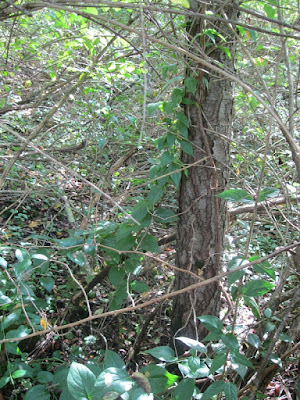Thursday, September 7, 2017
Alien Invader
Becky recently noticed this previously unknown to us plant growing next to our driveway. Her investigation revealed that this vine is as bad as the plague. Since we missed the flowers, we do not know if this is Pale Swallow-wort or Black Swallow-wort. Actual identification matters not since either must be removed and destroyed. Dig it, black plastic bag it then bake it in the sun until nothing plantlike remains. This area will require future watching to insure that we have indeed removed all of it.
This small plant was growing under the tangle in this spot. We must attempt to remove the larger plants as completely as this small one. Anything less than 100% removal represents failure so we will be working this area almost forever. All growth will be removed and we will work to keep this ground devoid of any plant growth.
These seed pods will open releasing milkweed like seeds that float under silken parachutes. This plant is related to milkweed and Monarch butterflies do mistakenly lay eggs here. Unfortunately any larva trying to grow on these leaves will die. Both the wildly invasive habit of Swallow-wort that will choke out native plants and its negative impact of the Monarch butterfly mandate the removal and destruction of this plant. When this area is cleared, we will begin searching for other possible locations of this pest.
While we are on the topic of plant pests, here is another that in the end will reclaim our gardens. Quack grass grows in all of our abandoned fields. We work to remove it completely from our planting beds but where the garden and the field touch the quack grass reenters the cleared soil. This bit of ground was diligently cleared of all weeds this spring. Summer squash was planted here and a thick layer of mower ground tree leaves smothered weeds. This bed looked well tended and weed free all season. Now the squash was removed, the rotting leaves were pulled aside and the tips of this quack grass root system revealed themselves. Working carefully, the root was removed all of the way back to the edge of the field. A wood bark mulch fills a trench intended to separate the garden from the field. This system works well but it is not perfect. This root was removed intact and fall planted potatoes are going into this ground. The leaf mulch will be reapplied and all will appear great when the potatoes begin to grow come spring. We expect to remove new quack grass invaders and we will harvest a crop from what appears to be well tended ground. We also expect that quack grass will completely reclaim this ground within two years of our departure from this place. We know this because we have already seen this pest take back planting areas that we could not properly weed.
The following day tools were taken to the site of the invasion. We were surprised to discover a large number of these nasty plants growing in this waste area. The five foot long pry bar deeply penetrated the rocky ground allowing removal of both the above ground growth and the root mass. We fully expect that bits of root were broken off and left behind. Return visits in years to come will be necessary to keep this weed in check. Total eradication is our goal but we know that this plant will reappear here for several years to come.
These seed pods have changed color indicating their seeds will soon be mature, free to float away on the wind. In that regard we were lucky to discover these invaders when we did. We may leave behind bits of root to regrow but we bagged hundreds of seeds. Cooking inside of a black plastic trash bag will render these seeds unable to sprout. That in itself makes this a day well spent!
Subscribe to:
Post Comments (Atom)






2 comments:
Wow, I wasn't familiar with that plant. Good sleuthing, and that's great to thoroughly dispose of it--for all the reasons you mention!
Oh no! That's an awful plant. I have yet to see it in my garden (knock on wood), but I know it's around in my area. I do worry that it is growing somewhere in my woods and I just haven't found it yet. I struggle with tons of Oriental Bittersweet, as well as Purple Loosestrife in my detention pond. Always something! :(
Post a Comment